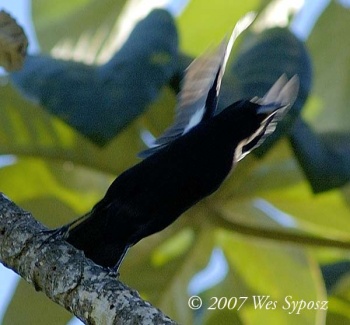(Picture captions tidied. References updated) |
|||
| (2 intermediate revisions by 2 users not shown) | |||
| Line 1: | Line 1: | ||
| − | [[Image:White-lined_Tanager_M.jpg|thumb|450px|right|Male | + | [[Image:White-lined_Tanager_M.jpg|thumb|450px|right|Male<br />Photo © by {{user|HelenB|HelenB}}<br />Sarapiquis Neotropical Center, [[Costa Rica]], 23 February 2007]] |
;[[:Category:Tachyphonus |Tachyphonus ]] rufus | ;[[:Category:Tachyphonus |Tachyphonus ]] rufus | ||
==Identification== | ==Identification== | ||
| − | [[Image:White-lined_tanager-underwings.jpg|thumb| | + | [[Image:White-lined_tanager-underwings.jpg|thumb|350px|right|Male showing the white linings under the wings<br />Photo © by {{user|Pantanal1|Pantanal1}} <br />Chapada dos Guimarães, Mato Grosso, [[Brazil]], 2007<br />Click on photo for larger image]] |
| − | + | 14 cm (5.5 in); 16g<br />Adult male is glossy black with a small, often concealed, white patch on the scapulars (photo - right). The white wing linings are only visible in flight, as shown in the photo, below right. <br /> | |
Adult female is rufous, paler below. Both have the typical tanager bill which is gray, but lower bill of the male is whiter, reminding of [[Silver-beaked Tanager]]. <br /> | Adult female is rufous, paler below. Both have the typical tanager bill which is gray, but lower bill of the male is whiter, reminding of [[Silver-beaked Tanager]]. <br /> | ||
Juvenile: like adult female, but duller with mottled appearance below. | Juvenile: like adult female, but duller with mottled appearance below. | ||
| Line 19: | Line 19: | ||
Open woods, scrubby, dense young second growth and also around rural houses, coming to feeding stations. | Open woods, scrubby, dense young second growth and also around rural houses, coming to feeding stations. | ||
==Behaviour== | ==Behaviour== | ||
| − | [[Image:White-lined Tanager female east of R o Macho de Monte Chiriqui Province Panama.jpg|thumb| | + | [[Image:White-lined Tanager female east of R o Macho de Monte Chiriqui Province Panama.jpg|thumb|350px|right|Female<br />Photo © by {{user|Stanley+Jones|Stanley Jones}}<br />Chiriqui Province, [[Panama]] 3 May 2012]] |
Forages low, gleaning insects and eating seeds and fruit. Also hawks flying insects or pounces on ground insects from a low perch. | Forages low, gleaning insects and eating seeds and fruit. Also hawks flying insects or pounces on ground insects from a low perch. | ||
Forms pairs throughout the year, nesting from April to July. | Forms pairs throughout the year, nesting from April to July. | ||
==References== | ==References== | ||
| − | #{{Ref- | + | #{{Ref-Clements6thAug19}}# Ber van Perlo. 2009. A field guide to the Birds of Brazil. Oxford University Press, New York, NY, USA. ISBN 978-0-19-530155-7 |
# Ridgely and Tudor 2009. Field guide to the songbirds of South America - the passerines. University of Texas Press, Austin, TX, USA. ISBN 978-0-292-71979-8 | # Ridgely and Tudor 2009. Field guide to the songbirds of South America - the passerines. University of Texas Press, Austin, TX, USA. ISBN 978-0-292-71979-8 | ||
# Ridgely & Gwynne 1989. Birds of Panama. Princeton Paperbacks. ISBN 0691025126 | # Ridgely & Gwynne 1989. Birds of Panama. Princeton Paperbacks. ISBN 0691025126 | ||
# Restall et al. 2006. Birds of Northern South America. Yale University Press. ISBN 9780300124156 | # Restall et al. 2006. Birds of Northern South America. Yale University Press. ISBN 9780300124156 | ||
| + | # [http://www.birdforum.net/showthread.php?t=301738 Birdforum thread] discussing identification of western Costa Rican birds | ||
| + | {{ref}} | ||
==External Links== | ==External Links== | ||
{{GSearch|Tachyphonus+rufus}} | {{GSearch|Tachyphonus+rufus}} | ||
[[Category:Birds]] [[Category: Tachyphonus ]] | [[Category:Birds]] [[Category: Tachyphonus ]] | ||
Latest revision as of 19:38, 29 July 2020
- Tachyphonus rufus
Identification
14 cm (5.5 in); 16g
Adult male is glossy black with a small, often concealed, white patch on the scapulars (photo - right). The white wing linings are only visible in flight, as shown in the photo, below right.
Adult female is rufous, paler below. Both have the typical tanager bill which is gray, but lower bill of the male is whiter, reminding of Silver-beaked Tanager.
Juvenile: like adult female, but duller with mottled appearance below.
Variation
On the Pacific slope of south-western Costa Rica and westernmost Panama, the males show a little brownish crown patch (usually concealed) and more white on wing coverts than other Central American birds.
Distribution
From Costa Rica through Central America and in South America from Colombia and Trinidad, through Venezuela and the Guianas to eastern and southern Brazil, eastern Bolivia, Paraguay and north-east Argentina; also in patches of Ecuador and Peru. Seems to avoid the western parts of the Amazon area.
Taxonomy
Habitat
Open woods, scrubby, dense young second growth and also around rural houses, coming to feeding stations.
Behaviour
Forages low, gleaning insects and eating seeds and fruit. Also hawks flying insects or pounces on ground insects from a low perch.
Forms pairs throughout the year, nesting from April to July.
References
- Clements, J. F., T. S. Schulenberg, M. J. Iliff, S. M. Billerman, T. A. Fredericks, B. L. Sullivan, and C. L. Wood. 2019. The eBird/Clements Checklist of Birds of the World: v2019. Downloaded from http://www.birds.cornell.edu/clementschecklist/download/
- Ber van Perlo. 2009. A field guide to the Birds of Brazil. Oxford University Press, New York, NY, USA. ISBN 978-0-19-530155-7
- Ridgely and Tudor 2009. Field guide to the songbirds of South America - the passerines. University of Texas Press, Austin, TX, USA. ISBN 978-0-292-71979-8
- Ridgely & Gwynne 1989. Birds of Panama. Princeton Paperbacks. ISBN 0691025126
- Restall et al. 2006. Birds of Northern South America. Yale University Press. ISBN 9780300124156
- Birdforum thread discussing identification of western Costa Rican birds
Recommended Citation
- BirdForum Opus contributors. (2024) White-lined Tanager. In: BirdForum, the forum for wild birds and birding. Retrieved 2 May 2024 from https://www.birdforum.net/opus/White-lined_Tanager






